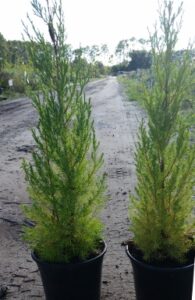S & J Nursery’s Guide to Growing
Eastern Red Cedar
in the Northeast Florida Landscape
( Juniperus virginiana )
NOTE: this page is being kept for informational purposes only as we are currently only growing the Florida native Southern Red Cedar Trees
Eastern Red Cedar / Juniperus virginiana Origins:
– The origins of Juniperus virginiana makes no sense to me, so
obviously I can’t explain it, but at least I can attempt to show you why it makes no sense to me.
These are the facts that confuse me, by sources I trust, although defiantly not without error as they are both written by humans and we make lots of those :
* UFIFAS lists on their 2006 document revision of Juniperus virginiana that it is Native to North America.
* In the 1998 revision of Michael Dirr’s “Manual of Woody Landscape Plants” – Under Native Habitat he lists … ” East and central North America, east of the Rocky mountains. Introduced before 1664.” And that’s it, not where it was thought to be introduced from, nada, nothing, zip.
So have the experts changed their minds? Are the Eastern Red Cedar and the Southern Red Cedar different species or the same species with differences depending on their genetics passed down from different locations… I defiantly do not have a clue, but often see it said in gardening literature that these are thought by some botanists to be the same species, maybe older books vs.. newer books? Will somebody explain the significance of a plant being introduced before 1664 , who do they think brought them here and why?
Or is ALL botanical classification just conjecture?
Ahh, the useless things that occupy my feeble mind!
Eastern Red Cedar / Juniperus virginiana Preferred Exposure:
– Plant your Eastern Red Cedar into a full sun location.
Foliage | Bark of the Eastern Cedar Juniperus virginiana:
– Evergreen foliage keeps stays green spring summer winter and fall. Deep
green color on mature foliage and an almost silvery green color on immature foliage.
– Typically a single trunked tree. Bark is green on new growth and
matures to a reddish brown coloring as it ages.
– Aromatic foliage and wood.
Soil Preference / Salt tolerance of the Eastern Red Cedar / Juniperus
virginiana:
– Eastern Red cedars are tolerant of a wide range of soil
conditions, acid, sandy dry soils, loam, alkaline, etc. as long as the soils are well draining.
– Moderate to High salt tolerance.
Size Variance of the Eastern Red Cedar Juniperus virginiana:
– Here in the Northeast Florida landscape, Eastern Red cedars will grow
to 40-50 feet in height with up to a 10-20 ft spread.
Growth Habit of the Eastern Red Cedar Tree:
– Strongly columnar when young aging to a slightly more pyramidal form as they age. branches can begin to droop with age as well.
– Can vary in the wild from almost columnar to broadly pyramidal.
– Long lived tree sometimes hundreds of years! There is said to be a specimen in Missouri that was almost 800 years old!
Growth Rate of Juniperus virginiana in Northeast Florida:
– Moderate to Fast growing trees capable of adding several feet to their
height in a single growing season.
Water Requirements of the Eastern Red
Cedar:
– Drought tolerant once established into the landscape from your S & J
Nursery container.
Blooms and Fruits / Butterfly or Bird Attracting:
– unknown
Best Uses For Eastern Red Cedar in the
Northeast Florida | Jacksonville | St. Augustine area landscape:
– The dense evergreen foliage of the Eastern Red Cedar makes it an ideal choice for a privacy screen to block out neighboring houses or unsightly
views.
– Perfect for a windscreen
– High salt tolerance makes Eastern Red Cedar an excellent coastal
planting.
– Drought tolerant and virtually maintenance free, the Eastern Red Cedar is an easy care landscape plant selection for the Northeast Florida landscape.
– Perfect shape for a living Christmas tree.
Care of Eastern Red Cedar:
– Water every day during the establishment period. See watering your newly planted trees for more information. Apply supplemental irrigation during prolonged periods of drought.
– Provide a 1 ft diameter circle of mulched area where grass is kept from growing for each inch of caliper (or diameter) of trunk measured 4 inches from the ground level.
– Fertilize each spring with a mixture of Milorganite and a slow release poly
coated plant food such as Osmocote or Stay Green general purpose plant food, sprinkling the fertilizer around the mulch circle underneath the foliage of the tree

